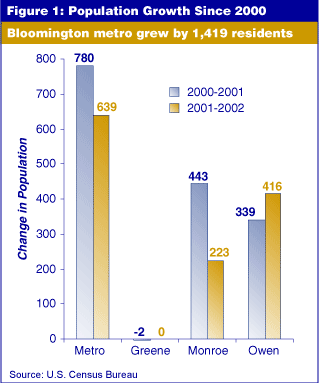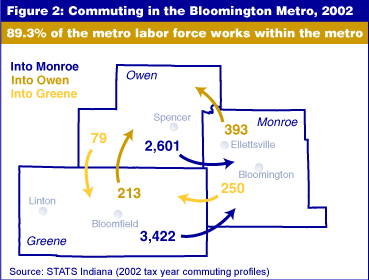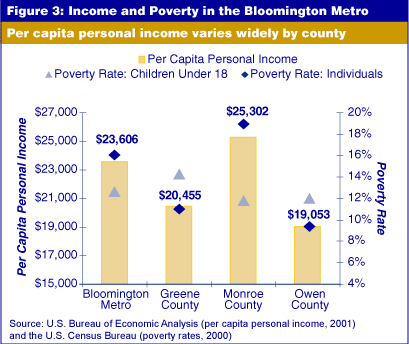The Bloomington Metro Area
The Area
The Bloomington Metropolitan Statistical Area (metro) is comprised of three south-central Indiana counties: Monroe, Owen and Greene. Aside from Bloomington itself, cities and towns in the metro include Linton, Ellettsville, Spencer and Bloomfield.
The Bloomington metro has nearly 177,000 residents, ranking it ninth among the 16 metro areas within the state, according to 2002 population estimates. Over 68 percent of the population live in Monroe County, with Greene and Owen counties accounting for 18.7 percent and 12.7 percent of the population, respectively.

While Monroe County has over five times the population of Owen County, the latter has outpaced Monroe County’s growth in both numeric and percentage terms since Census 2000 (see Figure 1). Coming off of a 26.1 percent growth rate during the 1990s, which ranked fourth in the state and was significantly higher than Monroe’s 10.6 percent, Owen County grew an additional 3.5 percent (755 people) between 2000 and 2002. Compare this to the 0.6 percent growth (666 residents) in Monroe County and the 1.3 percent increase in the state overall. Greene County’s population, on the other hand, has declined by a total of two people in the two years since 2000.
Projections from the Indiana Business Research Center have the Bloomington metro’s population topping 200,000 by 2020. Each of the six major age groups is expected to grow during this time, with the 45 to 64 age group increasing 31.2 percent and the 65 and older cohort increasing by 52 percent—rates that are higher than the state average.
Industrial Mix and Jobs
With Indiana University as a mainstay in the Bloomington economy, it is not surprising that 19.2 percent of the employment in the region was in educational services for the second quarter of 2003. Manufacturing employment followed at 13.4 percent, or about 9,500 jobs.
Between the second quarters of 2001 and 2003, the metro area lost 732 manufacturing jobs, a decline of 7.1 percent—a smaller decline than the state’s 8.1 percent. At the county level, Greene County lost 252 manufacturing jobs, declining by nearly 43 percent. Monroe County lost over 500 manufacturing jobs, a 6.3 percent decline. Manufacturing employment in Owen County, on the other hand, grew by 36 jobs, or 2.5 percent.
In December 2003, Winalta USA, a modular home manufacturer in Linton, closed, adding to Greene County’s woes with the loss of 80 more jobs. In Monroe County, Otis Elevator will cease all production at the end of 2004, keeping a staff of 200 as technical advisers, but leaving 165 others unemployed.
The life sciences industry has helped offset manufacturing losses in other areas of production, however. The Cook Group has its world headquarters in Bloomington, and its production of minimally invasive medical devices has a key impact on the local economy. Cook has several additional companies in the metro area, including Sabin Corp. in Bloomington and Cook Urological in Spencer. Baxter Healthcare in Bloomington and Boston Scientific in Spencer both play major roles in the metro’s life sciences industry as well. All in all, the Indiana Health Industry Forum has identified 14 life sciences–related companies in the area, making it one of the most health industry oriented economies in the southern half of the state.
Commuting Patterns
Of the nearly 103,000 people in the Bloomington metro area labor force, 89.3 percent worked within the metro area in 2002 (see Figure 2). About 5 percent commuted to the Indianapolis metro, with 2,305 Monroe County residents and 2,828 Owen County residents going to Indianapolis.

While the dominant portion of the Greene County labor force finds employment in Monroe County (16.2 percent), more employees at the Naval Surface Warfare Center Crane Division (NSWC Crane) are from Greene County than anywhere else. According to a report released by the Southern Indiana Business Alliance in 2003, the Martin County base employed 929 Greene County residents. When looking at both the direct and indirect jobs stemming from NSWC Crane, the result is employment for nearly 13 percent of Greene County’s labor force. Crane also accounted for $52.7 million in wages, or 20.5 percent of Greene County totals, according to the study.
Income and Wages
Per capita personal income (PCPI) for the Bloomington metro was $23,606 for 2001, over $3,900 below the state average. Monroe County came in at $25,302, while Owen County was a mere $19,053—ranking it 89th among the 92 counties. Along with PCPI, Figure 3 shows the Census 2000 poverty rates for the area. Monroe County’s abnormally high poverty rate among individuals ranked first in the state. However, this misleading statistic can mostly be attributed to the mass of Indiana University students who earn very little income during their tenure at the university.

College students also impact housing markets. While Monroe County’s PCPI was 8.8 percent lower than the state, median rent was 7.5 percent higher in 2000. At $560 a month, this was the 10th highest in the state. In contrast, Greene County ranked 87th out of the 92 counties at $375, while Owen County landed closer to the middle at $455 per month.
One must also take into consideration the difference in property values: the total assessed property values per capita were $5,820 for Greene County and $5,581 for Owen County. This ranked them 90th and 92nd, respectively, among Indiana’s 92 counties. Monroe County did significantly better with a total assessed property value per capita of $8,189; however, even that was $1,558 less than the state.
Wages for the second quarter of 2003 in the Bloomington metro were also lower than Indiana’s averages, except for a handful of industries. To illustrate the spectrum, those in finance and insurance earned $203 less per week than those in other parts of the state, while individuals employed in the management of companies and enterprises within the Bloomington metro earned a whopping $936 above the Indiana average each week.
Rachel Justis
IN Context Managing Editor, Indiana Business Research Center,
Kelley School of Business, Indiana University
